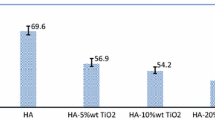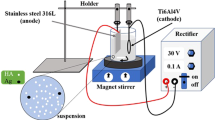Abstract
In this study, biocompatible ceramic layers containing TiO2 and hydroxyapatite (HA) nanoparticles (TiO2/HA) were deposited on pure commercial titanium (Grade 2) by using plasma electrolytic oxidation and AC power supply. The coating process was carried out in five different solutions for various times at a current density of 500 mA cm−2. To achieve the optimum conditions for thickness and microstructure, the coating process was conducted in solutions with a 3 g L−1 concentration of HA nanoparticles. FESEM, XRD, and FTIR results showed that HA nanoparticles were successfully incorporated into the pores of the layer. Furthermore, the corrosion behavior of the coating layers in the simulated body fluid was investigated with potentiodynamic polarization tests. It was observed that the corrosion current density of the samples coated in solutions with nanoparticles was decreased from 874 to 15 nA cm−2 in comparison with the coating with no HA particles. The reason for this behavior could be the presence of a composite coating containing TiO2/HA that seems to be stable. It firmly seems that during the crystal nucleation and growth process, phosphate and calcium ions formed a complex oxidation film while the hydroxide ions in the alkaline solution were attracted to the oxide film surface by the electric field and absorbed by the apatite particle for crystal growth.











Similar content being viewed by others
References
1. B Ben-Nissan. J Current Opinion in Solid State and Materials Science, 2003, vol. 7, pp. 283-288.
2. AL Yerokhin, A Leyland and A Matthews. J Applied Surface Science, 2002, vol. 200, pp. 172-184.
3. F Liu, F Wang, T Shimizu, K Igarashi, L Zhao. J Surf. Coat. Technol., 2005, vol. 199, pp. 220-224.
4. S Durdu, ÖF Deniz, I Kutbay, M Usta. J Journal of Alloys and Compounds, 2013, vol. 551, pp. 422-429.
5. P Huang, K-W Xu and Y Han. J Materials Letters, 2005, vol. 59, pp. 185-189.
6. L‐H Li, H‐W Kim, S‐H Lee, Y‐M Kong, H‐E Kim. Journal of Biomedical Materials Research Part A, 2005, vol. 73, pp. 48-54.
7. W-H Song, Y-K Jun, Y H and S-H Hong. J Biomaterials, 2004, vol. 25, pp. 3341-3349.
8. J Sun, Y Han, X Huang. J Surf. Coat. Technol., 2007, vol. 201, pp. 5655-5658.
9. D Wei, Y Zhou, D Jia and Y Wang. J Applied Surface Science, 2008, vol. 254, pp. 1775-1782.
10. Y Wang, T Lei, B Jiang and L Guo. J Applied Surface Science, 2004, vol. 233, pp. 258-267.
11. H Wu, X Lu, B Long, X Wang, J Wang and Z Jin. J Materials Letters, 2005, vol. 59, pp. 370-375.
12. AL Yerokhin, X Nie, A Leyland, A Matthews. J Surf. Coat. Technol., 2000, vol. 130, pp. 195-206.
13. T Kokubo and H Takadama. J Biomaterials, 2006, vol. 27, pp. 2907-2915.
TW Clyne and S Christopher. J International Materials Reviews Troughton, 2018, 63, pp. 1-36.
15. S Aliasghari, A Němcová, J Čížek, A Gholinia, P Skeldon and GE Thompson. J Transactions of the IMF 2016, vol. 94, pp. 32-42.
M Sivakumar, TSS Kumar, KL Shantha and KP Rao. J Biomaterials, 1996, vol. 17, pp. 1709-1714
17. WL Suchanek, K Byrappa, P Shuk, R E Riman, VF Janas and KS TenHuisen. J Biomaterials, 2004, vol. 25, pp. 4647-4657.
18. E Matykina, R Arrabal, B Mingo, M Mohedano, A Pardo, MC Merino. J Surf. Coat. Technol., 2016, vol. 307, pp. 1255-1264.
YS Jiménez, MT Gil, MT Guerra, L Baltes and JM Rosca. J Bulletin of the Transilvania University of Braşov, 2009, vol. 2, p. 51.
Acknowledgments
The authors are grateful to Sharif University of Technology for supporting this work through funding a Grant (G940306).
Author information
Authors and Affiliations
Corresponding author
Additional information
Publisher's Note
Springer Nature remains neutral with regard to jurisdictional claims in published maps and institutional affiliations.
Manuscript submitted November 16, 2018.
Rights and permissions
About this article
Cite this article
Soleymani Naeini, M., Ghorbani, M. & Chambari, E. Synthesis of Composite Coating Containing TiO2 and HA Nanoparticles on Titanium Substrate by AC Plasma Electrolytic Oxidation. Metall Mater Trans A 50, 3310–3319 (2019). https://doi.org/10.1007/s11661-019-05251-8
Received:
Published:
Issue Date:
DOI: https://doi.org/10.1007/s11661-019-05251-8




